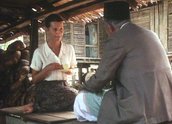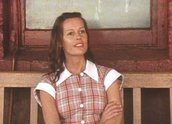


A Town Like Alice (1980)
Synopsis
A young Englishwoman, Jean Paget (Helen Morse), is a prisoner-of-war in Malaya at the time of the Japanese occupation (1941-45). On an enforced trek across the country she meets an Australian soldier, Joe Harmon (Bryan Brown). When the cruel Captain Sugamo (Richard Narita) discovers that he has been helping her and her companions, he forces the women and children to watch as Joe is beaten severely and left to die. The group is ordered to move on until they reach a small village where they shelter for the duration of the war.
Joe Harmon survives and searches for Jean in London but she has returned to Malaya with a gift of gratitude for the people of Kuala Telang. It is there she discovers that Joe is still alive. Being closer to Australia than London, she proceeds to Alice Springs in the hope that someone there will remember him and know where he is.
Reunited, Jean and Joe settle in Willstown, in Queensland’s Gulf Country where Joe manages a property that will one day be theirs. They’d both like to live in Alice Springs – a town first mentioned by Joe in one of their earliest conversations, giving Jean an enduring impression of order and beauty in a savage landscape. Living in Alice is as much a dream here as it was in the jungles of Malaya. Not, however, for the entrepreneurial Jean who sets about turning Willstown into 'a town like Alice’.
Curator’s notes
A Town Like Alice was a labour of love for producer Henry Crawford and director David Stevens and it shows. They deserve every credit not only for having got it made at a time when the mini-series as a genre was on shaky ground but for delivering an excellent final product. The much loved and highly acclaimed film of the same name, made in 1956 and also based on Nevil Shute’s best-selling novel (1950), concentrated on the love affair between Jean Paget and Joe Harmon that begins among the horror and deprivation of the war in Japanese-occupied Malaya and finds its resolution years later when the couple are reunited in the Australian outback.
A mini-series has the luxury of several hours to tell the story. The one major change by writers Tom Hegarty and Rosemary Anne Sissons – to enhance the role of solicitor Noel Strachan – is an improvement on Shute’s original plot. Played with intuitive understanding by Gordon Jackson, the character’s deep and unrequited attachment to Jean also provides a counterbalance to the melodrama of the great love story of Joe and Jean.
Courage, suffering and endurance in the extraordinary circumstance of war are often assumed to be the central theme of A Town Like Alice but in this series it is also about the courage to change. It is about flexibility on which, as Jean learns in Malaya, survival may depend; and about the imperative for change in any society that hopes for growth and a communal future, a lesson Jean learns of Alice and applies in Willstown. In the vernacular, 'a town like Alice’ is about 'giving it a go’, a quality we tend to think of as intrinsically Australian but which the heroine, an Englishwoman, has in spades.
It is also interesting that Shute, a man writing in the male-dominated world of the 1950s, chose a female character as his catalyst for change, a woman with an entrepreneurial spirit at a time when domesticity was considered to be the great feminine virtue. In keeping with this and the mood of the 1980s there is a strong sense of female empowerment throughout this adaptation. We are treated to several beautifully crafted performances by actresses of note, from the dour Mrs Frith (Dorothy Alison) and Anna Volska’s sparkling Sally Wilson-Hayes to a touching cameo by the late Arkie Whiteley as the Willstown barmaid Annie, a young girl trapped in a world as friendless as any the English children experienced a decade earlier in Malaya.
Jean Paget is played by Helen Morse with a careful intelligence and luminous warmth in what is an almost perfect performance. As well, Bryan Brown seems born to play Joe Harmon, so convincing is he in the role but it would be a mistake to think that he succeeds merely on instinct. Joe is not an easy character to understand, wildly impulsive in some ways, deeply cautious and conservative in others. It takes skill and discipline to forge both sides of his character and make it look natural and easy.
The music by Bruce Smeaton, often a single piano line, has a lyrical, rippling quality that evokes the flow of time and the changing tides of history but can be, at the same time, intimate and personal. In the same way, director David Stevens and cinematographer Russell Boyd collaborate to make the most of some spectacular scenery without in any way allowing it to distract from the human drama of the story.
First aired in July 1981 on the Seven Network, A Town Like Alice rated an average 45.5 on the Eastern seaboard according to the old McNair Anderson rating system, which means that nearly half of all TV sets turned on at the time were tuned to this program. This makes it the top-rating mini-series ever in Australia before 2001 when the ratings system changed and comparisons are made difficult. Alice was also the most expensive television drama then made at a budget of $225,000 AUD an hour, a sum with a buying power of around a million dollars today.
Its wide popularity and many awards suggest the money was well spent. It was picked up by the BBC and Masterpiece Theatre (1971–current) in the US as well as Paramount. Its success thoroughly scotched gloomy predictions that the mini-series genre would never take off in Australia, an attitude that had been prompted by a flat response to Water Under the Bridge (1980). It’s fair to say that A Town Like Alice heralded a golden era for the Australian mini-series: in the decade 1980–90 a total of 116 mini-series were produced with budgets averaging some $7 million per title in today’s terms.
- Overview
- Curator’s notes
- Video 3 clips
- Principal credits
- Find a copy
- Comments 2
- Map
- Add your review



